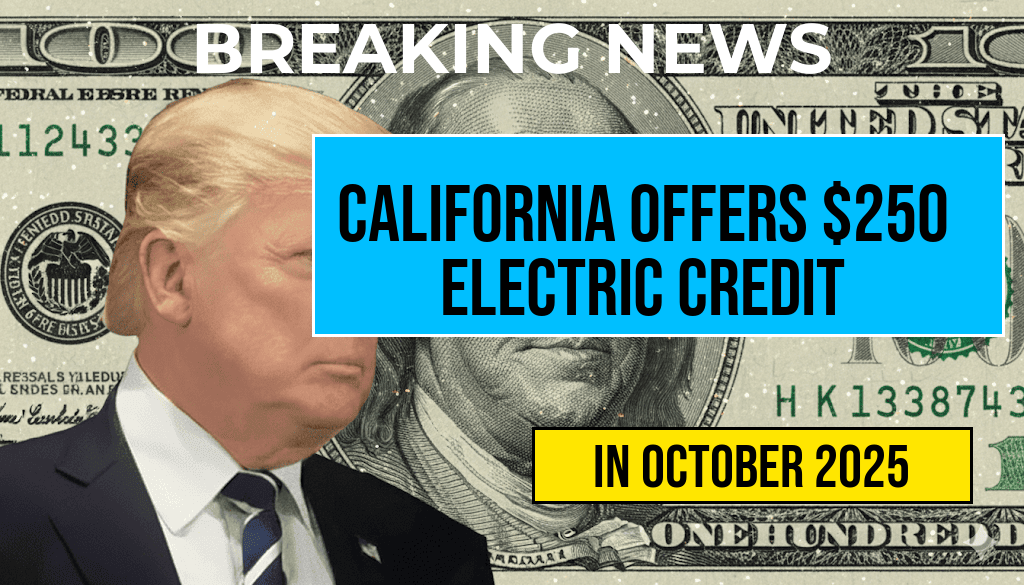California has announced a new initiative that will provide direct payments of up to $250 to over 11.5 million households as part of its Electric Credit Program. The state government aims to support residents facing rising energy costs amid ongoing efforts to transition to cleaner energy sources. The program, which is expected to distribute approximately $2.8 billion in total, offers targeted relief to low- and moderate-income families, renters, and those most impacted by the recent increases in electricity prices. Eligible households can receive a one-time payment or credit adjustment, depending on their specific circumstances, with the goal of easing financial burdens and promoting equitable access to sustainable energy solutions.
Details of the Electric Credit Program
Eligibility Criteria and Application Process
- Income Limits: Households earning up to 200% of the federal poverty level qualify for the program.
- Residency Requirements: Participants must reside within California and be connected to the state’s utility grid.
- Application Window: Applications open on July 1, 2024, and close on September 30, 2024.
- How to Apply: Eligible households can apply online through the California Department of Community Services and Development website or via participating local agencies.
Types of Payments
| Household Type | Maximum Credit | Payment Type |
|---|---|---|
| Low-income renter households | $250 | One-time direct payment or bill credit |
| Homeowners with moderate income | $200 | Bill credit applied over the next billing cycle |
| Other qualifying households | $150 | One-time credit |
Funding and State Goals
The Electric Credit Program is part of California’s broader strategy to address energy affordability and accelerate the shift to renewable sources. The allocated funds are drawn from the state’s climate investment initiatives, which aim to reduce greenhouse gas emissions while supporting economic resilience among vulnerable populations. According to state officials, the program will help mitigate the impact of recent energy rate hikes, which have been driven by increased costs associated with California’s ambitious clean energy mandates.
Expected Impact and Broader Context
California’s move to provide direct financial relief aligns with national trends emphasizing targeted assistance for households most susceptible to energy cost fluctuations. As electricity prices climb nationwide, policymakers are increasingly adopting direct payment models to ensure equitable access to affordable energy. This program is also designed to complement existing assistance programs, such as the Low Income Home Energy Assistance Program (LIHEAP), by offering immediate relief during peak energy seasons.
Community and Stakeholder Reactions
Many advocates have welcomed California’s initiative, emphasizing its role in reducing energy poverty and supporting economic stability. California’s energy policies have long prioritized renewable energy, making affordability a key concern. Consumer groups highlight that direct payments can help families avoid difficult choices between paying for electricity and other essentials like food and housing.
Utility companies also support the program, noting that it encourages timely bill payments and reduces disconnections. However, some critics argue that the funds are a temporary fix and emphasize the need for long-term solutions to reduce energy costs sustainably.
Future Outlook and Additional Support Measures
California continues to explore comprehensive measures to address energy affordability, including investments in energy efficiency upgrades and expanded rebates for clean energy appliances. The Electric Credit Program represents a targeted effort to provide immediate support, while policymakers maintain a focus on systemic reforms to lower overall energy prices.
More information about the program, including application details and eligibility, is available on the California Department of Community Services and Development website. As the state navigates its energy transition, balancing environmental goals with economic accessibility remains a central challenge.
Frequently Asked Questions
What is the California Electric Credit Program?
The California Electric Credit Program is a new initiative that provides direct payments of up to $250 to eligible households to help offset electricity costs.
How many households are eligible for the payments?
Over 11.5 million households across California are eligible to receive direct payments through this program.
How will the payments be distributed to eligible households?
The payments will be issued as direct deposits or checks, depending on the household’s existing payment method, making the process quick and convenient.
What are the eligibility criteria for receiving the electric credit?
Eligibility is based on household income, electricity usage, and income assistance program participation. Specific criteria are outlined by the California utility agencies to ensure aid reaches those most in need.
When will the payments be distributed?
Distributions are expected to begin soon, with details provided by the California utility authorities. Households are encouraged to stay informed through official channels for updates on payment schedules.







